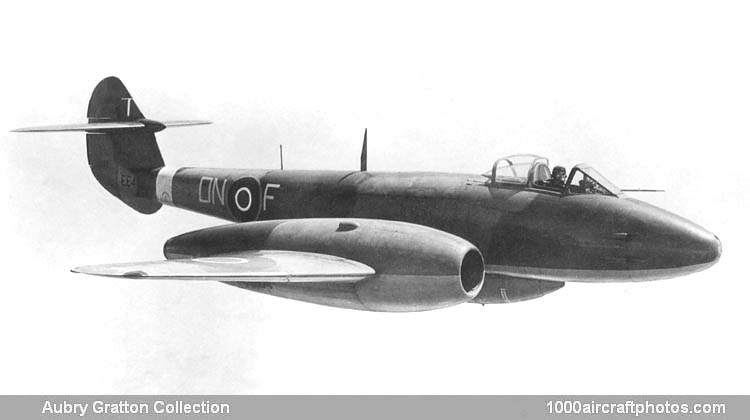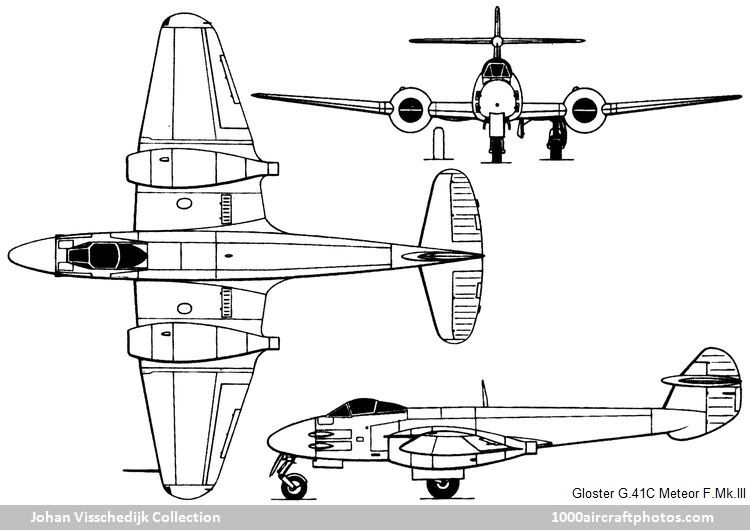06/30/2011. Remarks by Johan Visschedijk: "The Meteor F.Mk.III was designed to take full advantage of the more powerful Whittle W.2B/37 engine (produced by Rolls-Royce as the Derwent Series I) and embodied a sliding canopy, increased internal fuel capacity, slotted air brakes and a strengthened airframe. A production batch of 210 aircraft ordered under contract No. 6/ACFT/I490.C.B.7(b) (serials EE230 to EE254, EE269 to EE318, EE331 to EE369, EE384 to EE429, EE444 to EE493) were built in five sub batches by Gloster Aircraft Co. Ltd. during 1944-46.
Because Derwents were not available, the first Meteor F.Mk.III made its maiden flight early on September 11, 1944, powered by two 1,700 lb Whittle W.2B/23C engines (produced by Rolls-Royce as the Welland), and the first 15 aircraft were similarly powered. The remaining 195 F.Mk.IIIs, starting with EE245, had the 2,000 lb thrust Derwents. Following experience of long-chord nacelles on Meteor F.Mk.1 (EE211), the last fifteen F.Mk.IIIs (EE479 to EE493) were fitted with this type of nacelle.
Deliveries of Welland-powered Meteor F.Mk.IIIs to the RAF began on December 18, 1944, when EE231 went to No. 616 Squadron at Manston. In January 1945 one flight went to the 2nd Tactical Air Force in Belgium and was later joined by Meteors of No. 504 Squadron. Derwent-powered F.Mk.IIIs equipped Fighter Command's first jet fighter wing comprised of Nos.56, 74 and 245 Squadrons at RAF Bentwaters. Eventually the F.Mk.III equipped also RAF Squadrons Nos. 1, 63, 66, 92, 124, 222, 257, 263, 266, and 500.
Of the 210 Meteor F.Mk.IIIs produced, more than 30 were used for development trials and various other tasks, among them were EE230 (to A&AEE for flame damping trials); EE246, EE338, EE416 (to Martin Baker for ejector seat trials; EE249 (W2/700 jets and pressure cabin); EE314 (to Rolls-Royce for engine flight development work, later re-issued to the Central Gunnery School); EE338 (four cannon removed and nose-mounted cameras installed); EE360 (became F.Mk.4 prototype); EE361 (to Canada for winterization trials); EE363 (to Rolls-Royce for long-chord nacelle trials); EE389, EE397 (flight-refueling trials); EE445 (to Armstrong Whitworth for boundary layer control trials with Griffiths wing); EE454, EE455 (to RAF High Speed Flight for World Speed Record attempt).
Unique among Meteor trials was the deck-landing assessment of EE337 and EE387. Boscombe Down report No. 817/f of April 28, 1950, covered 32 landings on HMS Implacable during which pilots found the Meteor to have better deck-landing qualities than any other jet aircraft tested at A&AEE. Both aircraft had Derwent 5 engines in short nacelles, a strengthened landing gear for 11.5 ft (3.51 m)/sec rate of sink and a Sea Hornet V-frame arrester hook under the rear fuselage.
A number of F.Mk.IIIs went abroad, EE240 to USA; EE311 to Canada; EE384 to EE386 and EE388 to EE393 to Argentina; EE395 to New Zealand (serialed NZ6001); EE427 to Australia (serialed A77-1); and EE429 to South Africa. Over fifty became instructional airframes.
One of the last F.Mk.IIIs produced and one of the fifteen with the long-chord nacelles, the pictured aircraft is fitted with a ventral tank and is wearing full Day Fighter scheme colors. The code ON-F on the fuselage was applied when the aircraft entered service with RAF No. 124 Squadron, after the squadrons disbandment on April 1, 1946, the squadron code ON was transferred to No. 56 Squadron, and so was the pictured aircraft."

